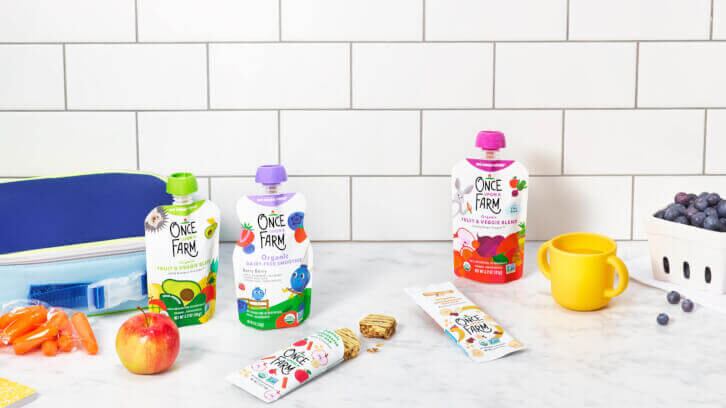Sixty percent of the 651 packaged foods for children six to 36 months old sold in the top 10 grocery chains in the US last year failed to meet nutritional recommendations set by the World Health Organization Regional Office for Europe, according to research published today in the scientific journal Nutrients.
The researchers, based at The George Institute for Global Health at the University of New South Wales, also found none of the products complied with WHO’s promotional requirements, with almost all the products including at least one claim on pack that was prohibited under WHO’s nutrient and promotional profile model (NPPM) and which could mislead consumers about the healthfulness of the product.
They also noted the rapid expansion of pouch packaging for baby and toddler food in the US market and expressed concern that most children squeeze the contents into their mouths, rather than using a spoon or experiencing the ingredients beyond taste.
“These findings highlight that urgent work is needed to improve the nutritional quality of commercially produced infant and toddler foods in the United States. The high use of … claims [prohibited by WHO] also suggests the need to regulate the type and number of claims allowed on pack,” the researchers conclude.
First steps
The researchers explained that they used WHO standards, even though US manufacturers are not required to comply with them, because “no nutrition or promotional guidelines currently exist in the United States” for these products, despite what they characterize as “growing concern over the increasing popularity and health impact” of packaged infant and toddler foods.
“Each country has some different guidelines when it comes to the food supply more broadly … but there is no specific regulation [in the US] for the baby food sector, except for infant formula,” and limited recommendations for children under 2 years in the most recent Dietary Guidelines for Americans, said Elizabeth Dunford, one of six researchers named in the study with ties to The George Institute for Global Health and the Department of Nutrition at Gillings Global School of Public Health at the University of North Carolina at Chapel Hill.
As such, she explained to FoodNavigator-USA, she and her co-authors assessed the nutrition and promotion of infant and toddler food using the WHO guidelines, even though they are European-based, because “we thought this would be a good first step to shine a spotlight on this sector.”
Based on their findings, she said, another “first step” for US policymakers and manufacturers could be to learn from other high-income countries that more tightly regulate the nutrition and promotion of baby and toddler food.
‘These findings should serve as a wake-up call for policymakers’
Of the products examined by the researchers, only 43.1% complied with WHO’s nutrition requirements, with the lowest compliance among all products for protein content and the highest for total fat.
Just over half (55.6%) of products complied with total sugar recommendations, according the study, which Dunford said is particularly worrisome given other research she conducted that revealed a “huge increase in sugar” in the baby food sector over the last 10 to 15 years.
“We do know that there is more and more sugar going into baby food specifically,” but because it often comes from fruit it may not be listed as “added sugar,” and therefore caretakers may not be as aware of it, she said.
She added that the sugar content in squeeze pouches is particularly high compared to other package formats. The study found that 93.5% of pouches failed to meet total sugar requirements.
Potentially problematic promotional claims
Shortfalls in the nutritional content of some baby and toddler foods could be compounded by promotional claims on pack that are allowed in the US but prohibited by the WHO criteria.
According to the study, all of the products reviewed had at least one claim deemed inappropriate by WHO. Dunford added that the most frequent promotional claims could mislead consumers about the products’ nutritional value because they had a “health halo.”
Of the 14 high-level category claims examined, the most frequent related to safety and the environment (79.6%), led by non-GMO claims (69.9%), no BPA claims (37.3%) and no pesticides (4.6%).
“This was followed by general health and nutrition claims that were present on 62.1% of products overall,” including organic on 59.3%, ‘weaning’ claims on 3.4% and whole foods claims on 3.2%, according to the study.
The most common specific ingredient claims on pack were no artificial colors or flavors, no preservatives and no added sweeteners, it added.
“These findings should serve as a wake-up call for policymakers. The prolific use of prohibited claims demonstrates the need to regulate the type and number of claims that can be used on product packaging, ensuring caregivers are not misled by the deceptive labeling that is currently used,” the researchers wrote.
Are pouches problematic?
The study also found pouches are the fastest growing packaging type in infant foods, with sales increasing 900% between 2010 and 2023, which Dunford said was alarming given these products both contain high levels of sugar on average and could stunt the development of healthy eating patterns.
She explained most children squeeze or suck the contents directly from the pouch, even when the packaging directs caregivers to use a spoon or feed from a dish. As such, Dunford said, they are not touching, smelling and seeing the ingredients to fully experience them and they are not practicing eating with utensils.
“Consequently,” the study concluded, “a reduction in the use of promotional claims and in the sugar content and energy content (particularly for pouches), should form the basis of future policies in the infant and toddler food sector in the United States.”




